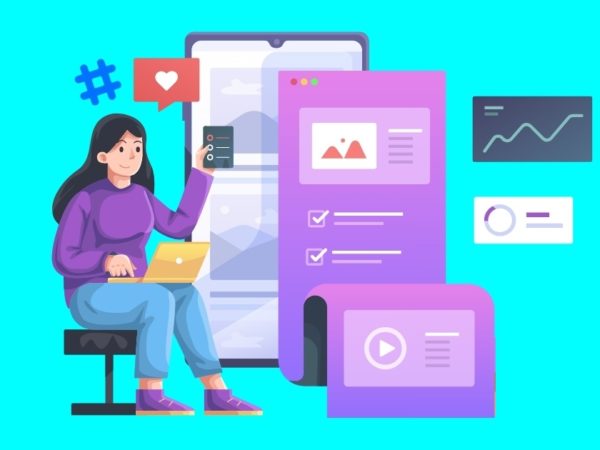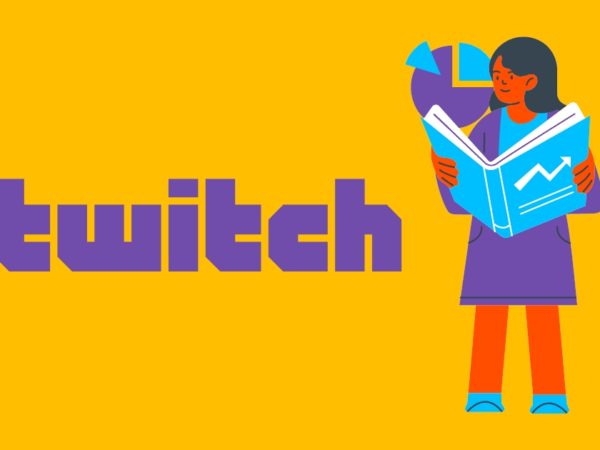The internet is going to be cookieless! So how will you measure advertising ROI? Just use a data clean room. But how, why, and what? To know, read on!
Online marketers and advertisers rely heavily on third-party cookies. For data privacy, Google (Chrome), Apple (Safari), Mozilla, Microsoft (Edge), etc., are discontinuing third-party cookies.
But PPC advertising needs accurate attribution and analytics to prove its utility. If marketers cannot track cookies, it will become difficult to retrieve metrics for such campaigns.
It is a sustainable service that can fill the upcoming vacuum of cookie tracking. Read on to learn more about it and its allied concepts from the ground up.
What Is Data Clean Room?
<img alt="YouTube video" data-pin-nopin="true" data-src="https://kirelos.com/wp-content/uploads/2022/12/echo/hqdefault.jpg63998ebb7cf31.jpg" height="360" loading="lazy" src="data:image/svg xml,” width=”480″>
PPC advertising uses customer data through third-party cookies for measurement, personalization, insights, and targeting. However, the ever-growing number of cyber incidents forced many governments and global organizations to restrict user data tracking.
The leading web browser software developers are ending third-party cookie tracking support. This is the choice of tool for user tracking in the PPC ecosystem.
Data clean room technology replaces the risky practice of user cookie tracking. With this newer customer data platform access trend, businesses can get controlled data, comprehensive analytics, and secure data collaboration. You can track your target audience while complying with GDPR and California Consumer Privacy Act (CCPA).
It is a closed and encrypted environment where brands can access audience data from data warehouses and media platforms securely. The clean room collects the data, cleans it, segments the data, and masks it with encryption.
You can still match the third-party user data with first-party data without knowing raw user data like name, address, location, and other personally identifiable information (PII) data.
Why Do Brands Need Data Clean Room Service?
A data clean room is the most suitable option for data collaboration between businesses involving customer data without facing privacy lawsuits.
The audience is now using walled garden internet, third-party cookie blockers, and other means to prevent personal identifiers from leaking into the internet. On top of that, Google, Apple, and other tech giants are disabling third-party cookie support in devices, apps, and web browsers.
Hence, you need data clean rooms to recreate customer journeys and discover user insights using audience data in a responsible way.
A popular example of this growing concern is Apple’s iOS 14 update will not allow user insights into Facebook Ads. Hence, Facebook marketers can not target iPhone 14 users. However, you can use it to overcome the challenge while complying with all privacy regulations.
In a nutshell, PPC advertisers and campaign managers need a data clean room for the followings:
- PPC Campaign measurement
- Customer and audience analysis
- Target audience segmentation
- New user activation
How Does a Data Clean Room Work?
The managed service provider (MSP) or SaaS-based data clean rooms process first-party data from brands and audience data from media houses.
The workflow includes encrypting, pseudonymization, demographic segmentation, restricted access, noise injection, and differential privacy. Ultimately, you get data sets that help you track audience activity, market trends, PPC success rates, etc., without violating GDPR and CCPA.
Here is a summary of tasks:
Data Aggregation
The MSP or SaaS app aggregates first-party data (attribution, CRM, and websites) and third-party data (partners, publishers, brands, and media networks) into one database. Then, it uses various artificial intelligence (AI) and machine learning (ML) concepts to sort data. The database keeps valid data and discards useless data.
Data Anonymization
The software then anonymizes the data so that the marketing agency or business that uses the audience data can not personally locate specific individuals. Such anonymization does not negatively impact the ultimate goal of marketers, like tracking leads, sending cart abandon emails, or recreating user journeys.
Connecting Data
MSPs also use third-party data enrichment tools to match first-party data with the target audience. Again, the data is encrypted so accessing PIIs at this level is virtually impossible.
Data Analytics
The data clean room app itself does some data analytics work, as mentioned below:
- Attribution tracking
- Intersections and overlaps using Python
- Propensity score analysis (PSA)
Applications in Digital Marketing
Finally, marketers can put various datasets to good use according to their PPC strategy. For example, you can do the followings with cleaned and matched data from data clean rooms:
- Reach out to the relevant audience
- Develop the base of interested leads and prospects
- Perform frequency and reach measurement
Benefits of Data Clean Room
Replace Third-Party Cookies
More and more companies are disabling the use of third-party cookies. However, marketers can still collect the necessary data through a data clean room, which is a secure and better alternative to cookies.
Compliance With Data Privacy Regulations
Many countries in the world have become concerned about the data privacy of their citizens. As a result, we have seen compliances such as GDPR and CCPA. The data clean room service complies with all the major privacy regulations about personal user data. Hence, using the data produced by this service means you are adhering to all the compliances.
Upholding Consumer Trust
End-users of your products also need some privacy. Using the insights gathered from the data clean room for marketing and promotion, you do not violate their privacy. Thus, you can prove yourself as a trustworthy company.
Reinforce Strategic Relationship
Choosing a secure and privacy-first mode of collaboration with your strategic partners helps you improve R&D, product strategy, and value analysis. Thus, you can continue exploring better opportunities with them.
Utilize a Variety of Datasets
Advertisers and marketers can create customized audience groups from the collected user data. With better user segmentation, targeting the right category of consumers becomes possible.
Get Trending Data
From data clean rooms, marketers can get aggregated user information about the trends of various sectors. Whether it is about different user groups, demographics, and industries, you can get the required data from the service providers.
Challenges of Data Clean Room
Interoperability
Major data cleanroom providers like Google and Facebook only offer aggregated user information for their platforms. It is known as the single platform approach or the walled garden approach.
This method bars you from combining data from multiple platforms together.
Lack of Standardization
So far, there is no standardization in this technology. Different service providers use various methodologies and formats to aggregate and access the data. Hence, you will get the data in different formats if you accumulate them from multiple platforms.
Absence of Quality Data
Since marketers do not have direct access to first-party data, data quality depends solely upon the data providers. Also, one can not independently verify data accuracy and quality.
Not Suitable for Small User Groups
Besides all the above-mentioned points, data clean rooms cannot offer insights into a small group of users. The companies even set a minimum user count limit before sharing the results with marketers and businesses.
For example, if you use Google Ads Data Hub, the platform must have 50 users’ data to share the combined results.
Risks of Data Clean Room Services
Data Breach
Advertisers need to share first-party data with data clean room platforms for insights. If there is an incident of data breach or cyberattack, the data might fall into the wrong hands. Consequently, companies have to face hefty fines, a bad reputation, and a loss of client base.
Human Errors
If companies decide to manage the platforms manually, the process might become prone to human errors. Inaccurate query formatting, accidental data access to unauthorized people, and data transfer through unsecured channels are some of the incidents that can make the data clean room a risky process.
Security
Depending on the companies one has to cater to, the service providers have to enforce security at various levels. Otherwise, a data leak can take place.
Types of Data Clean Room
#1. Pure or Neutral
These are managed data clean rooms offered as SaaS solutions to businesses, startup brands, and media houses. Since MSPs offer services, you do not need any in-house data scientist to analyze data.
Such solutions offer more value to your investment towards a safe and secure technology to offer personalized ads to your audience.
You can use marketing datasets from such solutions in different ad ecosystems like Google, Facebook, Amazon, Bing, etc.
#2. Walled Garden
<img alt="YouTube video" data-pin-nopin="true" data-src="https://kirelos.com/wp-content/uploads/2022/12/echo/hqdefault.jpg63998ebe0641d.jpg" height="360" loading="lazy" src="data:image/svg xml,” width=”480″>
It is the most popular and widely used type. Big IT companies like Google, Facebook, and Amazon own such data clean rooms. You can only use first-party and third-party advertisement data within a select ad ecosystem.
For example, Google Ads Data Hub (ADH) is only for the Google Ads ecosystem and will not work on Amazon or Facebook.
#3. Non-Standard
Cloud marketing and data storage service providers have created niche data clean rooms. For example, BlueConic is a CDP service provider and has announced this service. You can only use the solution within BlueConic.
Likewise, cloud-computing platform Snowflake and marketing software provider Epsilon have similar individual solutions for their existing or new customers.
Such solutions also do not allow you to export datasets to walled garden solutions and vice versa.
Customer Data Platform Vs. Data Clean Room
<img alt="YouTube video" data-pin-nopin="true" data-src="https://kirelos.com/wp-content/uploads/2022/12/echo/hqdefault.jpg63998ebe16444.jpg" height="360" loading="lazy" src="data:image/svg xml,” width=”480″>
Advertisers and media houses use CDPs to manage and collect audience data. Data clean rooms can augment and enhance the use cases of CDPs in marketing data handling. However, there are some differences, and these are:
| Functionalities | CDP | Data Clean Room |
| User Data Privacy | Nominal, prone to hacks and leakages | Virtually impossible to hack or breach data privacy |
| Data Type | First-party user data with PII | First-party and third-party matched data without PII |
| Security Levels | Basic like permission-based access | High-level security with encryption keys and deciphers |
| Cross Company Compatibility | CDP data is company-centric | Datasets found in these tools are useful for any business that opts for online marketing |
Data Clean Room: Alternatives
Here are some alternatives:
#1. Universal IDs
Being a perfect alternative to cookies, it will help advertisers to make cross-network attribution easier. It uses email ids to create hashed IDs and collect data from all major ad platforms anonymously.
#2. Contextual Targeting
This old ad-targeting method is back on the scene, letting marketers show ads based on the context of the page the user is visiting. One can even make this strategy more effective by incorporating other data from the publisher.
#3. Google Privacy Sandbox
<img alt="YouTube video" data-pin-nopin="true" data-src="https://kirelos.com/wp-content/uploads/2022/12/echo/hqdefault.jpg63998ebe1cf9b.jpg" height="360" loading="lazy" src="data:image/svg xml,” width=”480″>
This platform anonymizes user data and accumulates the customers based on shared attributes. It is better at protecting user privacy while allowing advertisers to run and measure their marketing campaigns.
Future of Data Clean Room
In the future, this technology will become the go-to service for advertisers to send targeted ads to their audience. They will also use managed datasets from this service to measure campaign performance, gather insights, and make forecasts.
Gartner says that 80% of online advertisers with huge media budgets will shift to data clean rooms by 2023. To cater to this huge requirement, tech giants have invested in this technology since 2017.
Existing services in this domain are Google Ads Data Hub, Amazon Marketing Cloud (AMC), InfoSum, Disney Advertising Sales, and more.
The above enterprises have already conveyed their interest in increasing the budget for the development, maintenance, and marketing of data clean rooms.
Author’s Note on Data Clean Room
According to Data Intelo, the PPC advertising market will grow at 10% CAGR until 2030. It has been in the $14.5 billion revenue range in 2017. However, the existing technologies to send personalized ads and track customer journeys will soon sunset.
Data clean room will become the single most tool to optimize PPC the way you do it now. Hence, you can expect billions of dollars in revenue in this domain on the global stage. If you are a marketing fresher or digital marketing agency, you need to embrace it now!
Wrapping Up
If you are a digital marketer, ad agency owner, individual business entrepreneur, or enthusiast about current customer data access technologies, you must know the data clean room.
This technology will help you to navigate your future effort for PPC campaign analytics. Besides, you will also get managed services when you opt for data-clean room service.
Next up are the best CIAM tools and proven data cleansing strategies.



